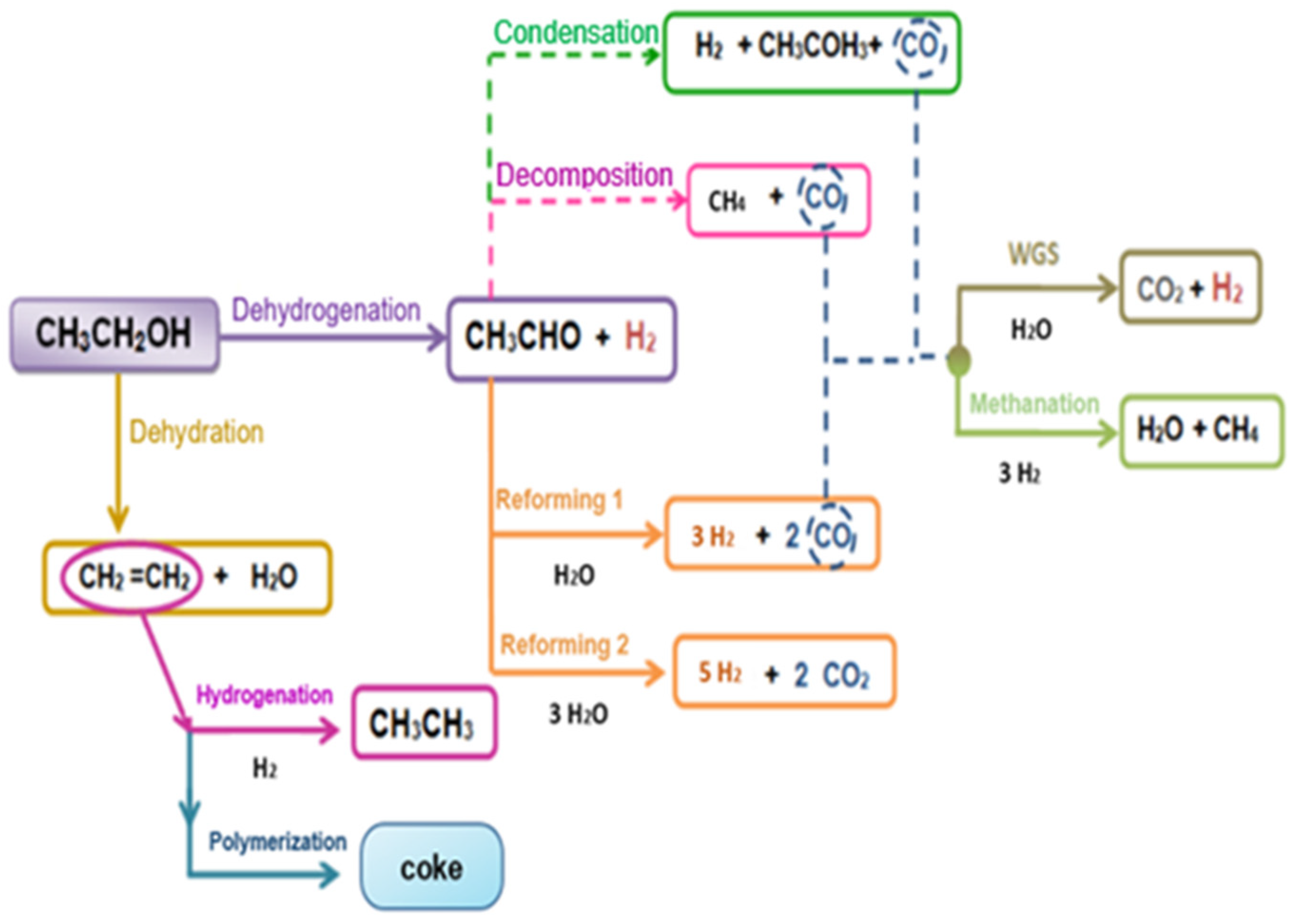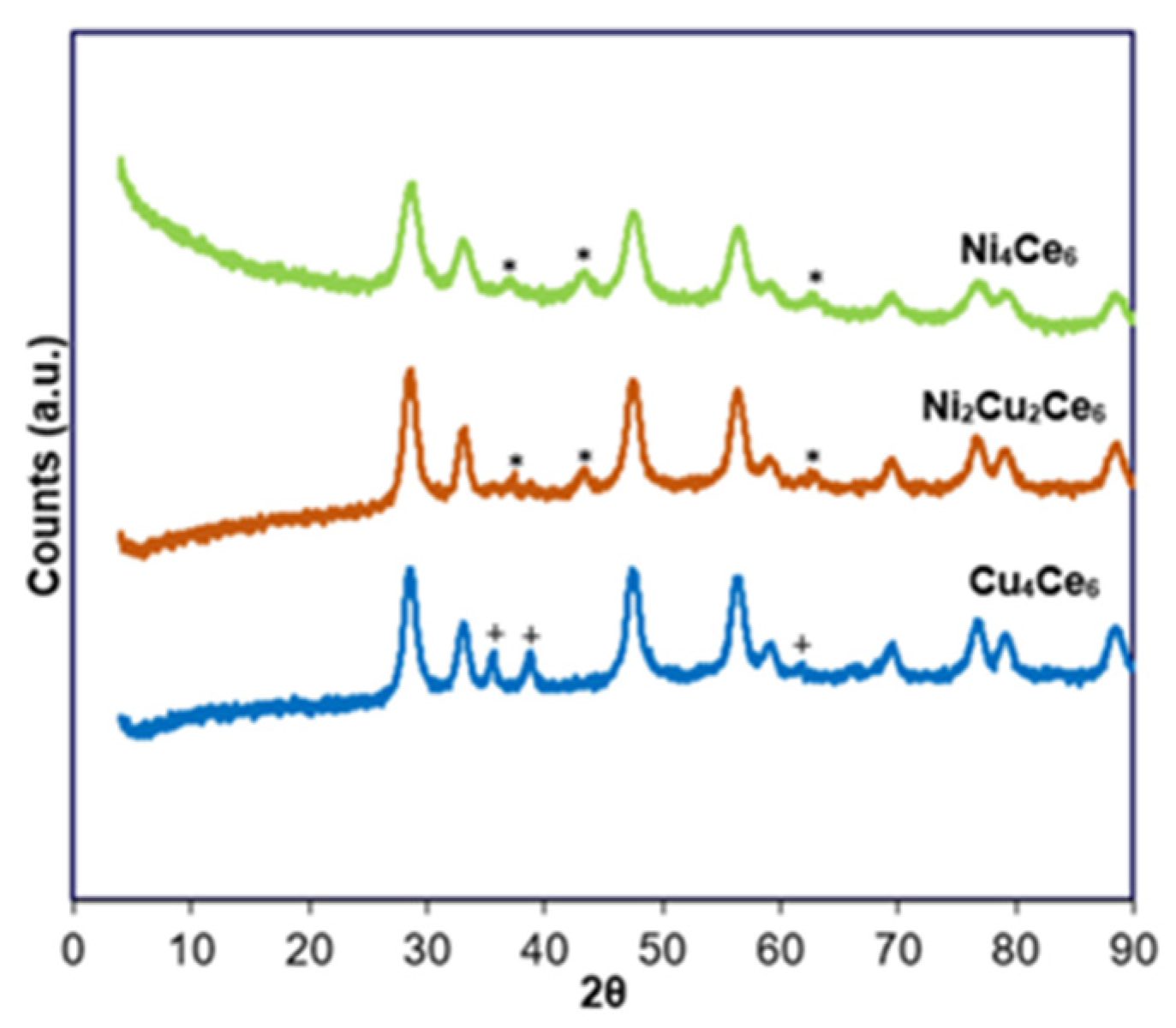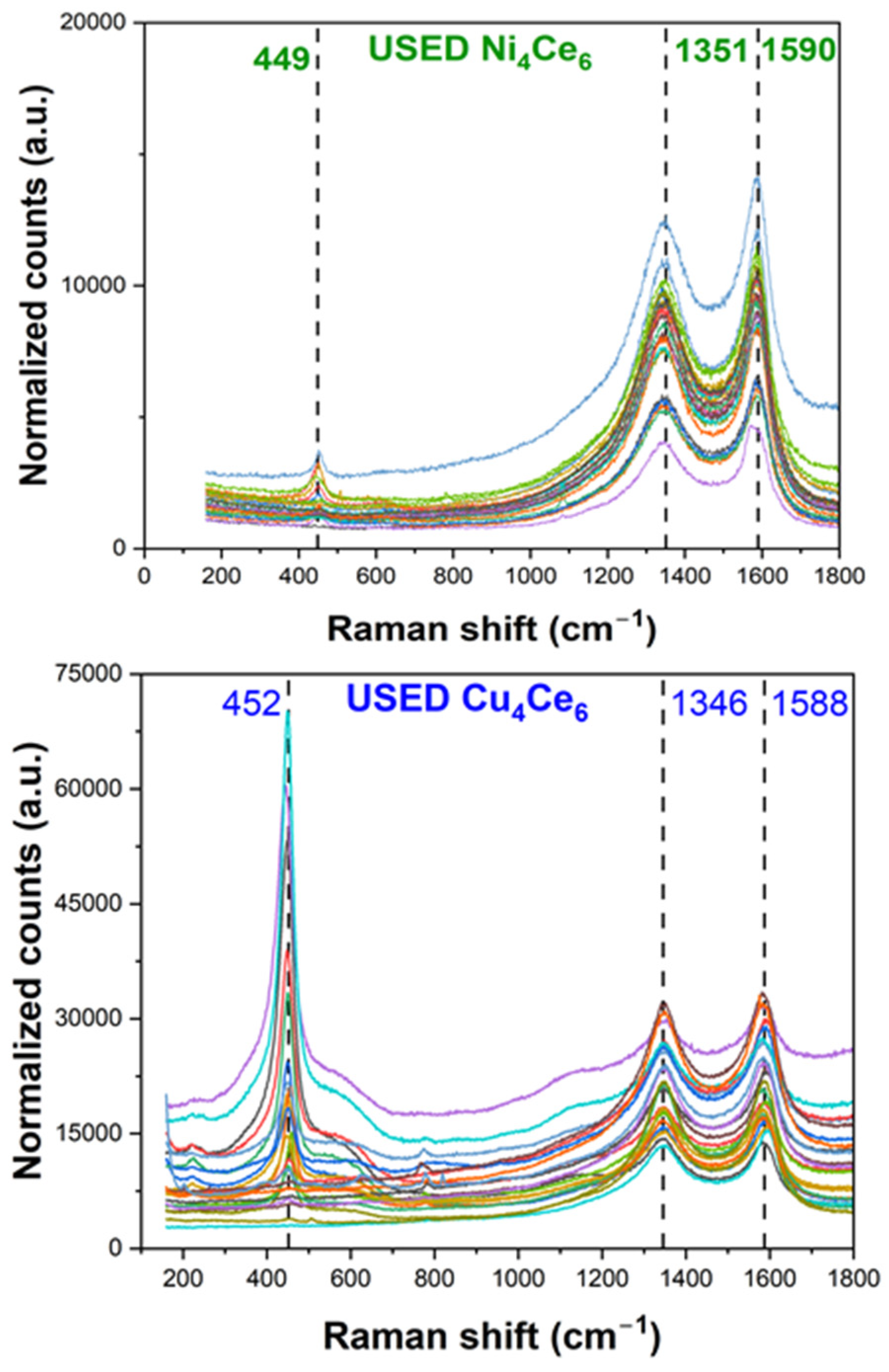Influence of the Interaction of Nickel and Copper with Ceria on Ethanol Steam Reforming over Ni-Cu-CeO2 Catalysts
Abstract
:1. Introduction
2. Results and Discussion
2.1. Characterization of Fresh Catalysts
2.2. Catalytic Activity
2.3. Characterization of Used Catalysts
2.4. Structure/Activity Relationships
3. Materials and Methods
3.1. Synthesis of the Catalysts
3.2. Physicochemical Characterization
3.3. Catalytic Activity
4. Conclusions
Supplementary Materials
Author Contributions
Funding
Data Availability Statement
Acknowledgments
Conflicts of Interest
References
- Greluk, M.; Rotko, M.; Turczyniak-Surdacka, S. Enhanced catalytic performance of La2O3 promoted Co/CeO2 and Ni/CeO2 catalysts for effective hydrogen production by ethanol steam reforming. Renew. Energy 2020, 155, 378–395. [Google Scholar] [CrossRef]
- Goh, C.S.; Aikawa, T.; Ahl, A.; Ito, K.; Kayo, C.; Kikuchi, Y.; Takahashi, Y.; Furubayashi, T.; Nakata, T.; Kanematsu, Y.; et al. Rethinking sustainable bioenergy development in Japan: Decentralised system supported by local forestry biomass. Sustain. Sci. 2019, 15, 1461–1471. [Google Scholar] [CrossRef]
- Chiou, J.Y.; Lai, C.L.; Yu, S.W.; Huang, H.H.; Chuang, C.L.; Wang, C.B. Effect of Co, Fe and Rh addition on coke deposition over Ni/Ce0.5Zr0.5O2 catalysts for steam reforming of ethanol. Int. J. Hydrogen Energy 2014, 39, 20689–20699. [Google Scholar] [CrossRef]
- Mattos, L.V.; Jacobs, G.; Davis, B.H.; Noronha, F.B. Production of Hydrogen from Ethanol: Review of Reaction Mechanism and Catalyst Deactivation. Chem. Rev. 2012, 112, 4094–4123. [Google Scholar] [CrossRef] [PubMed]
- Llorca, J.; Cortés Corberán, V.; Divins, N.J.; Olivera Fraile, R.; Taboada, E. Hydrogen from Bioethanol, Renewable Hydrogen Technologies: Production, Purification, Storage, Applications and Safety; Gandia, L.M., Arzamedi, G., Dieguez, P.M., Eds.; Elsevier: Amsterdam, The Netherlands, 2013; pp. 135–169. [Google Scholar]
- Sharma, Y.C.; Kumar, A.; Prasad, R.; Upadhyay, S.N. Ethanol steam reforming for hydrogen production: Latest and effective catalyst modification strategies to minimize carbonaceous deactivation. Renew. Sustain. Energy Rev. 2017, 74, 89–103. [Google Scholar] [CrossRef]
- Feng, X.; Zhao, Y.; Zhao, Y.; Wang, H.; Liu, H.; Zhang, Q. A minireview on recent progress of steam reforming of ethanol. RSC Adv. 2023, 13, 23991–24002. [Google Scholar] [CrossRef]
- Araiza, D.G.; Gómez Cortés, A.; Díaz, G. Effect of ceria morphology on the carbon deposition during steam reforming of ethanol over Ni/CeO2 catalysts. Catal. Today 2020, 349, 235–243. [Google Scholar] [CrossRef]
- Liu, J.; Su, W.; Rick, J.; Yang, S.; Pan, C.; Lee, J.; Chen, J.; Hwang, B. Rational design of ethanol steam reforming catalyst based on analysis of Ni/La2O3 metal–support interactions. Catal. Sci. Technol. 2016, 6, 3449–3456. [Google Scholar] [CrossRef]
- Osorio Vargas, P.; Flores González, N.A.; Navarro, R.M.; Fierro, J.L.G.; Campos, C.H.; Reyes, P. Improved stability of Ni/Al2O3 catalysts by effect of promoters (La2O3, CeO2) for ethanol steam-reforming reaction. Catal. Today 2016, 259, 27–38. [Google Scholar] [CrossRef]
- Zhurka, M.D.; Lemonidou, A.A.; Kechagiopoulos, P.N. Elucidation of metal and support effects during ethanol steam reforming over Ni and Rh based catalysts supported on (CeO2)-ZrO2-La2O3. Catal. Today 2021, 368, 161–172. [Google Scholar] [CrossRef]
- Mariño, F.; Baronetti, G.; Jobbagy, M.; Laborde, M. Cu-Ni-K/γ-Al2O3 supported catalysts for ethanol steam reforming: For-mation of hydrotalcite-type compounds as a result of metal–support interaction. Appl. Catal. A 2003, 238, 41–54. [Google Scholar] [CrossRef]
- Carrero, A.; Calles, J.; Vizcaíno, A. Effect of Mg and Ca addition on coke deposition over Cu–Ni/SiO2 catalysts for ethanol steam reforming. Chem. Eng. J. 2010, 163, 395–402. [Google Scholar] [CrossRef]
- Lytkina, A.; Zhilyaeva, N.; Ermilova, M.; Orekhova, N.; Yaroslavtsev, A. Influence of the support structure and composition of Ni–Cu-based catalysts on hydrogen production by methanol steam reforming. Int. J. Hydrogen Energy 2015, 40, 9677–9684. [Google Scholar] [CrossRef]
- Mariño, F.; Cerrella, E.; Duhalde, S.; Jobbagy, M.; Laborde, M. Hydrogen from steam reforming of ethanol. cCharacterization and performance of copper-nickel supported catalysts. Int. J. Hydrogen Energy 1998, 23, 1095–1101. [Google Scholar] [CrossRef]
- Lorenzut, B.; Montini, T.; De Rogatis, L.; Canton, P.; Benedetti, A.; Fornasiero, P. Hydrogen production through alcohol steam reforming on Cu/ZnO-based catalysts. Appl. Catal. B 2011, 101, 397–408. [Google Scholar] [CrossRef]
- Niazi, Z.; Irankhah, A.; Wang, Y.; Arandiyan, H. Cu, Mg and Co effect on nickel-ceria supported catalysts for ethanol steam reforming reaction. Int. J. Hydrogen Energy 2020, 45, 21512–21522. [Google Scholar] [CrossRef]
- Greluk, M.; Gac, W.; Rotko, M.; Słowik, G.; Turczyniak-Surdacka, S. Co/CeO2 and Ni/CeO2 catalysts for ethanol steam reforming: Effect of the cobalt/nickel dispersion on catalysts properties. J. Catal. 2021, 393, 159–178. [Google Scholar] [CrossRef]
- Xu, W.; Liu, Z.; Johnston Peck, A.; Senanayake, S.D.; Zhou, G.; Stacchiola, D.; Stach, E.A.; Rodriguez, J.A. Steam Reforming of Ethanol on Ni/CeO2: Reaction Pathway and Interaction between Ni and the CeO2 Support. ACS Catal. 2013, 3, 975–984. [Google Scholar] [CrossRef]
- Liu, Z.; Senanayake, S.D.; Rodriguez, J.A. Elucidating the interaction between Ni and CeOx in ethanol steam reforming cat-alysts: A perspective of recent studies over model and powder systems. Appl. Catal. B 2016, 197, 184–197. [Google Scholar] [CrossRef]
- Xiao, Z.; Wu, C.; Wang, L.; Xu, J.; Zheng, Q.; Pan, L.; Zou, J.; Zhang, X.; Li, G. Boosting hydrogen production from steam reforming of ethanol on nickel by lanthanum doped ceria. Appl. Catal. B Environ. 2021, 286, 119884. [Google Scholar] [CrossRef]
- Pinton, N.; Vidal, M.; Signoretto, M.; Martínez-Arias, A.; Cortés Corberán, V. Ethanol steam reforming on nanostructured catalysts of Ni, Co and CeO2: Influence of synthesis method on activity, deactivation and regenerability. Catal. Today 2017, 296, 135–143. [Google Scholar] [CrossRef]
- Jampa, S.; Jamieson, A.M.; Chaisuwan, T.; Luengnaruemitchai, A.; Wongkasemjit, S. Achievement of hydrogen production from autothermal steam reforming of methanol over Cu-loaded mesoporous CeO2 and Cu-loaded mesoporous CeO2–ZrO2 catalysts. Int. J. Hydrogen Energy 2017, 42, 15073–15084. [Google Scholar] [CrossRef]
- Faraldos, M.; Goberna, C. (Eds.) Técnicas de Análisis y Caracterización de Materiales; Editorial CSIC: Madrid, Spain, 2002; ISBN 84-00-08093-9. [Google Scholar]
- Mullins, D.; Overbury, S.; Huntley, D. Electron spectroscopy of single crystal and polycrystalline cerium oxide surfaces. Surf. Sci. 1998, 409, 307–319. [Google Scholar] [CrossRef]
- Holgado, J.P.; Alvarez, R.; Munuera, G. Study of CeO2 XPS spectra by factor analysis: Reduction of CeO2. Appl. Surf. Sci. 2000, 161, 301–315. [Google Scholar] [CrossRef]
- Fernández García, M.; Martínez Arias, A.; Hanson, J.C.; Rodriguez, J.A. Nanostructured Oxides in Chemistry: Characteriza-tion and Properties. Chem. Rev. 2004, 104, 4063–4104. [Google Scholar] [CrossRef]
- Gonzalez Elipe, A.R.; Holgado, J.P.; Alvarez, R.; Munuera, G. Use of factor analysis and XPS to study defective nickel oxide. J. Phys. Chem. 1992, 96, 3080–3086. [Google Scholar] [CrossRef]
- Grosvenor, A.P.; Biesinger, M.C.; Smart, R.S.C.; McIntyre, N.S. New interpretations of XPS spectra of nickel metal and oxides. Surf. Sci. 2006, 600, 1771–1779. [Google Scholar] [CrossRef]
- Peck, M.A.; Langell, M.A. Comparison of Nanoscaled and Bulk NiO Structural and Environmental Characteristics by XRD, XAFS, and XPS. Chem. Mater. 2012, 24, 4483–4490. [Google Scholar] [CrossRef]
- Biesinger, M.C. Advanced analysis of copper X-ray photoelectron spectra. Surf. Interface Anal. 2017, 49, 1325–1334. [Google Scholar] [CrossRef]
- Wagner, C.D.; Davis, L.E.; Zeller, M.V.; Taylor, J.A.; Raymond, R.H.; Gale, L.H. Empirical atomic sensitivity factors for quantitative analysis by electron spectroscopy for chemical analysis. Surf. Interface Anal. 1981, 3, 211–225. [Google Scholar] [CrossRef]
- Laachir, A.; Perrichon, V.; Badri, A.; Lamotte, J.; Catherine, E.; Lavalley, J.C.; El Fallah, J.; Hilaire, L.; Le Normand, F.; Quéméré, E.; et al. Reduction of CeO2 by hydrogen. Magnetic susceptibility and Fourier-transform infrared, ultraviolet and X-ray photoelectron spectroscopy measurements. J. Chem. Soc. Faraday Trans. 1991, 87, 1601–16094. [Google Scholar]
- Gamarra, D.; Cámara, A.L.; Monte, M.; Rasmussen, S.B.; Chinchilla, L.E.; Hungria, A.B.; Munuera, G.; Gyorffy, N.; Schay, Z.; Cortés Corberán, V.; et al. Preferential oxidation of CO in excess H2 over CuO/CeO2 catalysts: Characterization and performance as a function of the exposed face present in the CeO2 support. Appl. Catal. B Environ. 2013, 130–131, 224–238. [Google Scholar] [CrossRef]
- Li, G.; Hu, L.; Hill, J.M. Comparison of reducibility and stability of alumina-supported Ni catalysts prepared by impregnation and co-precipitation. Appl. Catal. A Gen. 2006, 301, 16–24. [Google Scholar] [CrossRef]
- Zhang, Y.; Qin, Z.; Wang, G.; Zhu, H.; Dong, M.; Li, S.; Wu, Z.; Li, Z.; Wu, Z.; Zhang, J.; et al. Catalytic performance of MnOx–NiO composite oxide in lean methane combustion at low temperature. Appl. Catal. B Environ. 2012, 129, 172–181. [Google Scholar] [CrossRef]
- He, L.; Ren, Y.; Fu, Y.; Yue, B.; Tsang, S.C.E.; He, H. Morphology-Dependent Catalytic Activity of Ru/CeO2 in Dry Reforming of Methane. Molecules 2019, 24, 526. [Google Scholar] [CrossRef]
- Shabu, R.; Raj, A.M.E.; Sanjeeviraja, C.; Ravidhas, C. Assessment of CuO thin films for its suitablity as window absorbing layer in solar cell fabrications. Mater. Res. Bull. 2015, 68, 1–8. [Google Scholar] [CrossRef]
- Xu, J.F.; Ji, W.; Shen, Z.X.; Li, W.S.; Tang, S.H.; Ye, X.R.; Jia, D.Z.; Xin, X.Q. Raman spectra of CuO nanocrystals. J. Raman Spectrosc. 1999, 30, 413–415. [Google Scholar] [CrossRef]
- Popovic, Z.V.; Dohcevic-Mitrovic, Z.; Cros, A.; Cantarero, A. Raman scattering study of the anharmonic effects in CeO2−y nanocrystals. J. Phys. Condens. Matter 2007, 19, 496209. [Google Scholar]
- Zhang, F.; Chan, S.W.; Spanier, J.E.; Apak, E.; Jin, Q.; Robinson, R.D.; Herman, I.P. Cerium oxide nanoparticles: Size-selective formation and structure analysis. Appl. Phys. Lett. 2002, 80, 127–129. [Google Scholar] [CrossRef]
- Thema, F.T.; Manikandan, E.; Gurib-Fakim, A.; Maaza, M. Single phase Bunsenite NiO nanoparticles green synthesis by Agathosma betulina natural extract. J. Alloys Comp. 2016, 657, 655–661. [Google Scholar] [CrossRef]
- Bose, P.; Ghosh, S.; Basak, S.; Naskar, M.K. A facile synthesis of mesoporous NiO nanosheets and their application in CO ox-idation. J. Asian Ceram. Soc. 2016, 4, 1–5. [Google Scholar] [CrossRef]
- Yang, X.; Liu, W.; Pan, G.; Sun, Y. Modulation of oxygen in NiO: Cu films toward a physical insight of NiO: Cu/c-Si hetero-junction solar cells. J. Mater. Sci. 2018, 53, 11684–11693. [Google Scholar] [CrossRef]
- Shi, D.; Wojcieszak, R.; Paul, S.; Marceau, E. Ni Promotion by Fe: What Benefits for Catalytic Hydrogenation? Catalysts 2019, 9, 451. [Google Scholar] [CrossRef]
- Wang, X.; Rodriguez, J.A.; Hanson, J.C.; Gamarra, D.; Martínez Arias, A.; Fernández García, M. In situ studies of the active sites for the water gas shift reaction over Cu-CeO2 catalysts: Complex interaction between metallic copper and oxygen vacancies of ceria. J. Phys. Chem. B 2006, 110, 428–434. [Google Scholar] [CrossRef] [PubMed]
- Kubacka, A.; Martínez Arias, A.; Fernández García, M. Role of the Interface in Base-Metal Ceria-Based Catalysts for Hydrogen Purification and Production Processes. ChemCatChem 2015, 7, 3614–3624. [Google Scholar] [CrossRef]
- Lin, L.; Yao, S.; Liu, Z.; Zhang, F.; Li, N.; Vovchok, D.; Martínez Arias, A.; Castañeda, R.; Lin, J.; Senanayake, S.D.; et al. In Situ Characterization of Cu/CeO2 Nanocatalysts for CO2 Hydrogenation: Morphological Effects of Nanostructured Ceria on the Catalytic Activity. J. Phys. Chem. C 2018, 122, 12934–12943. [Google Scholar] [CrossRef]
- Dresselhaus, M.S.; Jorio, A.; Hofmann, M.; Dresselhaus, G.; Saito, R. Perspectives on Carbon Nanotubes and Graphene Raman Spectroscopy. Nano Lett. 2010, 10, 751–758. [Google Scholar] [CrossRef] [PubMed]
- Alberton, A.L.; Souza, M.M.; Schmal, M. Carbon formation and its influence on ethanol steam reforming over Ni/Al2O3 catalysts. Catal. Today 2007, 123, 257–264. [Google Scholar] [CrossRef]
- Gamarra, D.; Munuera, G.; Hungría, A.B.; Fernández-García, M.; Conesa, J.C.; Midgley, P.A.; Wang, X.Q.; Hanson, J.C.; Rodríguez, J.A.; Martínez-Arias, A. Structure−Activity Relationship in Nanostructured Copper−Ceria-Based Preferential CO Oxidation Catalysts. J. Phys. Chem. C 2007, 111, 11026–11038. [Google Scholar] [CrossRef]










| Catalyst | Textural Properties | XRD Data | |||
|---|---|---|---|---|---|
| Specific Surface Area (SBET) (m2/g) | Average Pore Size (nm) | Pore Volume (cm3/g) | CeO2 Lattice Parameter (nm) | CeO2 Crystal Size (nm) | |
| Ni4Ce6 | 57 | 4.8 | 0.068 | 0.539 | 6.4 |
| Ni2Cu2Ce6 | 42 | 9.3 | 0.097 | 0.540 | 8.6 |
| Cu4Ce6 | 30 | 12.7 | 0.094 | 0.540 | 8.8 |
| Sample | XPS Binding Energies of Observed Peaks, eV a | Atomic Ratios | |||
|---|---|---|---|---|---|
| Ni 2p3/2 | Cu 2p3/2 | O 1s | Ce3+ (%) | Ni (or Cu) /(M+Ce) b | |
| Ni4Ce6 | 854.2 (28.4) 856.0 (39.1) 861.5 (32.5) | 529.5 (62.4) 531.5 (37.6) | 13.2 | 0.12 | |
| Ni2Cu2Ce6 | 854.2 (27.0) 856.0 (41.0) 861.6 (32.0) | 933.2 (86.2) 935.4 (3.1) 943.4 (10.7) | 529.4 (55.0) 531.1 (27.5) 532.8 (17.5) | 17.6 | 0.10 (Ni) 0.17 (Cu) |
| Cu4Ce6 | 933.4 (39.0) 935.2 (44.0) 943.6 (17.0) | 529.8 (26.8) 531.2 (41.6) 532.9 (31.6) | 23.6 | 0.27 | |
Disclaimer/Publisher’s Note: The statements, opinions and data contained in all publications are solely those of the individual author(s) and contributor(s) and not of MDPI and/or the editor(s). MDPI and/or the editor(s) disclaim responsibility for any injury to people or property resulting from any ideas, methods, instructions or products referred to in the content. |
© 2024 by the authors. Licensee MDPI, Basel, Switzerland. This article is an open access article distributed under the terms and conditions of the Creative Commons Attribution (CC BY) license (https://creativecommons.org/licenses/by/4.0/).
Share and Cite
Pájaro, K.C.; Cortés Corberán, V.; Martínez-Arias, A. Influence of the Interaction of Nickel and Copper with Ceria on Ethanol Steam Reforming over Ni-Cu-CeO2 Catalysts. Catalysts 2024, 14, 605. https://doi.org/10.3390/catal14090605
Pájaro KC, Cortés Corberán V, Martínez-Arias A. Influence of the Interaction of Nickel and Copper with Ceria on Ethanol Steam Reforming over Ni-Cu-CeO2 Catalysts. Catalysts. 2024; 14(9):605. https://doi.org/10.3390/catal14090605
Chicago/Turabian StylePájaro, Karen C., Vicente Cortés Corberán, and Arturo Martínez-Arias. 2024. "Influence of the Interaction of Nickel and Copper with Ceria on Ethanol Steam Reforming over Ni-Cu-CeO2 Catalysts" Catalysts 14, no. 9: 605. https://doi.org/10.3390/catal14090605







